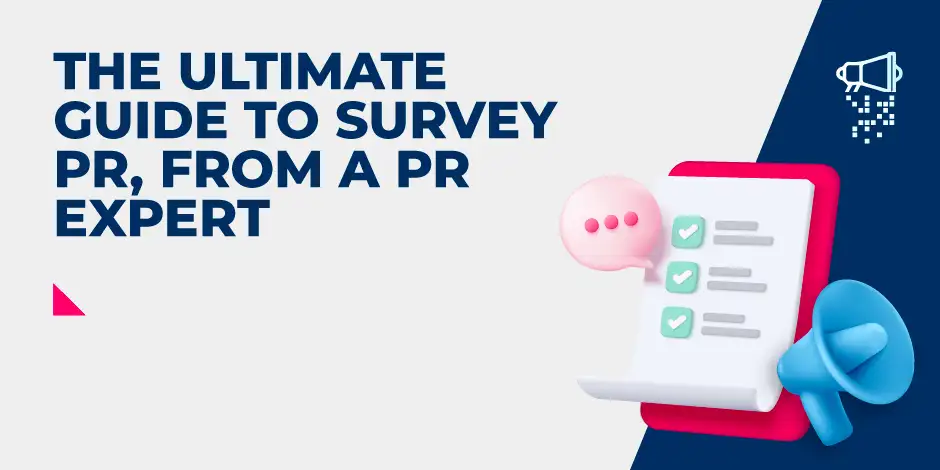
The Ultimate Guide to Survey PR, From a PR Expert
In the competitive world of PR, simply blasting out press releases is no longer enough to capture journalists' attention. To make an impact, PR pros need to get creative with their outreach efforts.
One proven tactic is leveraging survey data to generate buzzworthy headlines and compelling content. However, creating a successful survey PR campaign takes strategy and finesse. By using the right approach, your survey could become the talk of the town, driving links, coverage, and brand awareness.
So, how do the survey PR gurus develop campaigns that captivate audiences? Let's break down the secrets to survey success.
What is a Survey PR?
Surveys are great tools within digital marketing. They can be the basis of all different types of website content, infographics, social media posts, and lastly, press releases.

Survey PR involves conducting original research through surveys and polls to generate shareable data and insights. The survey results are then packaged into press releases, infographics, and other content formats to secure media coverage.
Survey-based campaigns and press releases are fantastic tools for a digital PR agency to utilise and can bring fresh, interesting data to the media. However, they must be carried out in a clear, accurate, and well-researched manner.
The team of digital PR experts at Reboot consistently use our ability to successfully construct a survey-based press release, which can enable our topic to appeal to the press and achieve high-quality, relevant links across a wide range of websites, which is ultimately key to our client’s SEO strategy.
How To Ideate for Your Survey Campaign
Ideating for your digital PR campaign is the first step to ensuring its success, this is no different for your survey PR campaigns. If you don’t consider any of the below, chances are you’ll be setting it up to fail.
Research the Search Landscape
Doing SERP and keyword research is a crucial first stage of survey campaigns. By looking at the search landscape, you can find out if there’s an appetite or space for your story.
Understanding the search landscape also reveals opportunities to position your digital PR onsite content asset and survey results so they have the best chance of ranking highly and earning organic backlinks.
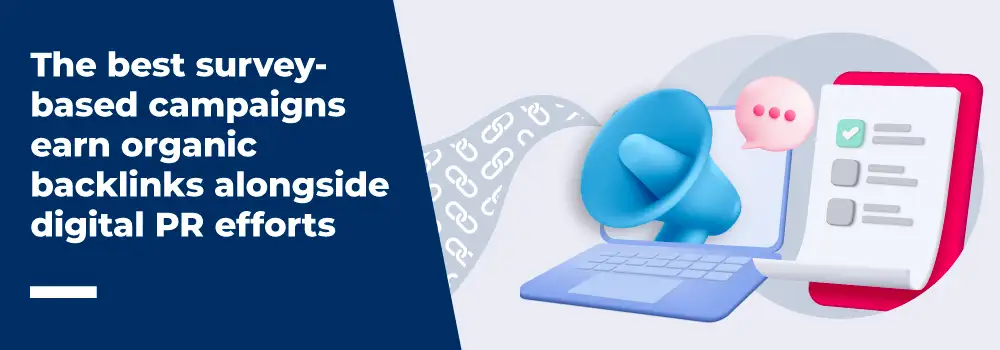
Additionally, using Google search commands to find out if your topic has been covered recently and what similar stories are in the news is useful in helping you understand if this is a topic that will pique the interest of journalists.
Will It Result in a Debate? (If So, Good!)
Emotion drives digital PR campaigns. That’s why it’s usually a good thing for your campaign if the topic and results it provides can spark a debate or get people talking. This can encourage journalists to get it on their website, as ultimately you want to provide them with news that will shock, inspire, spark interest, or provide new information.
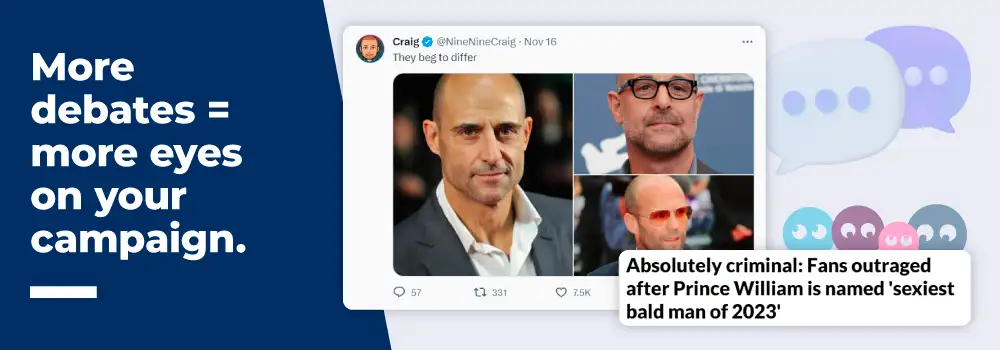
Publications like to be a part of the big conversations on the internet—they don’t want to be left out of the trends. If your campaign has the potential to generate chatter on social media then you increase the likelihood of target sites picking up the story too.
Factors such as regional divides in surveys, or strange, quirky responses can often work well to achieve a sense of surprise or debate.
Make Sure Your Idea Is Unique
Journalists don’t want to be told or sent things they have already seen a thousand times before. You should strive to make a unique, engaging idea, with new statistics and findings that will make them want to use it within their publication. It should appeal to their readership and add a valuable contribution to their publication.
Take a minute to look through the news stories based on survey data published within the last 24 hours.
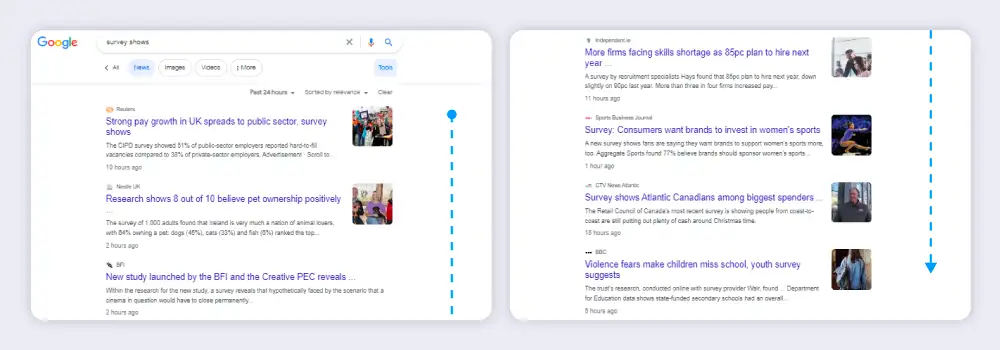
These are just the ones that have been published. Try to imagine how many are sent to journalists every day. Now you know why it’s so important to stand out from the crowd.
If you want your survey-based press release to be successful, it is key to ensure that the idea isn’t something that has already widely been discussed. If it is, there is a risk that journalists won’t find the concept newsworthy, or that they won’t find the results surprising or interesting enough to read.
How To Conduct a Survey Campaign
Once you have an idea for the topic of your survey campaign, it’s time to run the survey. It can be a daunting task as your success will depend on nailing these initial steps.
1. Choosing Your Questions
When choosing your survey questions, it is important to first look at the end point of what you want to achieve. You can then shape your questions around this to help you gain the type of statistics you require.
For example, are you looking for a simple yes/no stat? Then make sure you include a question that will result in this.
You don’t want to ask leading questions or phrase them in a way that is pushing them in a certain direction. For example, you wouldn’t want to ask a question like “How bad are you at driving?”, but “How would you rate your driving skill?” instead.
Having too many questions can also have a negative impact, as respondents may get bored, and fail to answer.
Plain, simple words and phrases are the safest to use. The group you’re surveying will most likely vary in their level of expertise and interest in the topic. If the question is too complicated to comprehend, there’s a risk of misunderstanding.
Lastly, make sure that you have considered various possible answers that may not be common responses. For example, if it is hard to predict a full range of answers on a topic, offering response options such as ‘I don’t know’ or ‘other, please specify’ can help those who may not have an option listed that suits them.
Put simply, good survey questions:

2. Choosing Your Respondents
Respondents can be chosen with various factors in mind, depending on what you want your campaign to cover. For example, age, gender, and city. Each of these factors will result in different angles and headlines.

Home location can be useful for creating regional hooks for your campaign and means you instil a sense of tribalism throughout the results. After all, regional publications are more likely to publish a campaign where their area is a central topic.
Information on the age of the respondents can create an interesting commentary on generational divides, while data on gender can also allow you to draw comparisons.
3. Choosing a Number of Responses
The ideal minimum number of respondents for a UK-based survey tends to be around 2,000, however, this can change depending on where you are conducting a survey. For example, a US-based survey would require more than this, for greater accuracy.
Put simply, if you’re looking to provide an accurate representation, then the bigger the population = the more respondents are needed.

You also need to take into account the response rate. Say you want 2,000 respondents but the expected response rate is only 20%, then you’ll need to send out 10,000 invitations.
If possible, try to allow a survey to run for some days to maximise responses. However, you can also set an end date, if your campaign is timely and includes trending topics that can change quite quickly.
How to Get the Most Out of Your Survey
When you receive your survey results, it is vital to spend time analysing and organising the data to ensure you can get the most out of it.
Utilising graphs or tables in Excel to do this can be helpful so that when it comes to picking out key statistics to use in your press release, it is easily visible to you as the writer. By doing this, you can potentially find numerous angles to use for your press releases and headlines.

Surveys also offer a large amount of depth and opportunity within their findings. If you find a statistic that seems too low to include, flip it around and utilise the higher statistic. For example, if 20% of people say they wouldn’t trust AI-generated work, this may mean 80% would, which can be extremely useful in constructing your press releases and headlines.
Consider demographics and locations within your survey. This can help you find regional or age-specific headlines, and other angles that journalists often find newsworthy.
How to Construct a High-Quality Survey-Based Press Release
The press release itself gives you the chance to showcase your findings in a way that will appeal to journalists within that sector. Therefore, the information must be laid out in an easy-to-understand, and interesting way.
1. Begin with an introduction that shows why this topic is newsworthy
Using a recent statistic from the news or trending search data here can work well to show journalists that the topic is something being discussed or searched for at present.

2. Include a ‘key findings’ section which can, if needed, be tailored to journalists depending on their area of interest
A ‘key findings’ or ‘study highlights’ section gives a snapshot of your survey results. It can help to catch a journalist’s attention and even make their jobs easier as they can see, at a glance, what the story is saying.
This section should lay out key statistics, whether that is the most shocking or interesting ones. These statistics should also be tailored for any regional findings so that geographical outreach is more effective.

3. Delve into the main survey findings
Create a table that clearly shows the statistics (ranked, if possible) you have chosen to use for the journalist to see the key information you are offering quickly. Journalists have thousands of emails to get through daily so they need to know within a few minutes if it's something they can use.
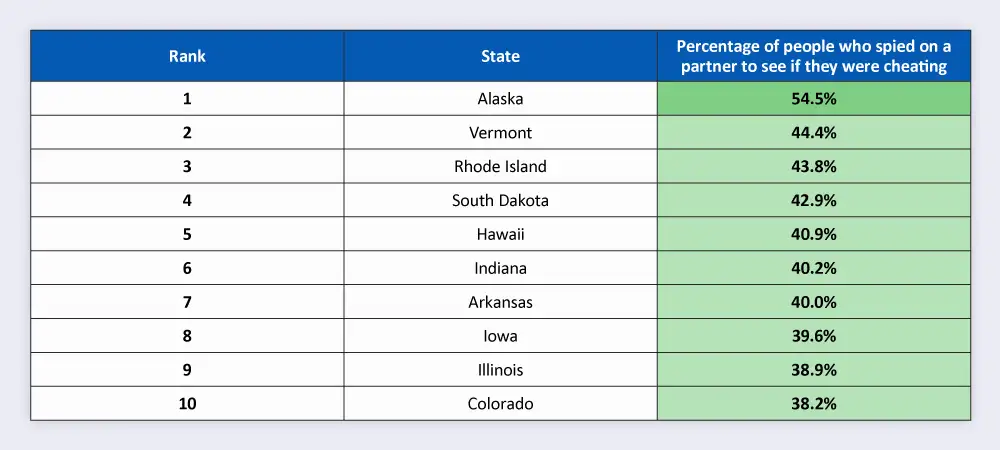
4. Explain the data in the table using concise sentences
Too much waffle in your press release can deter from the impact of the survey data itself. Keep to the point, and showcase the survey data. Include the most important or most impactful findings. Never try to pack all the survey information into one press release, this becomes too long and less impactful when a journalist is reading it.

5. Bring in expert commentary
If you can get an expert comment to back up or add more depth and information to your findings, this can serve as a fantastic way to round off your press release. Giving the journalist additional expert insight can add even more appeal and generate more linkability.
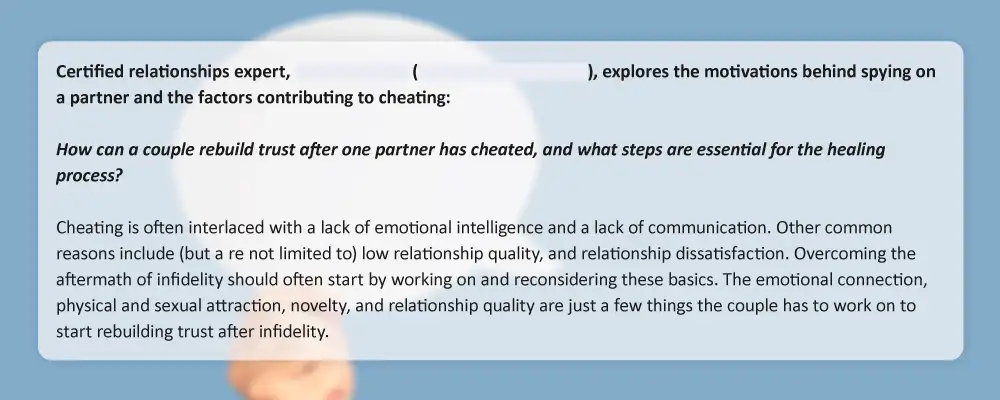
6. Have a clear methodology for the journalist to understand
Include the reason for the survey (what did you want to find out?), method used, and timing, as well as the number of people completing the questionnaire.
A good methodology should be simple, yet detailed enough, that it could be recreated if necessary.
The digital PR experts at SEO company, Reboot, can produce and run a survey PR campaign that will have your brand name in the biggest publications in your niche. Get in touch today to hear more about our results and packages.
